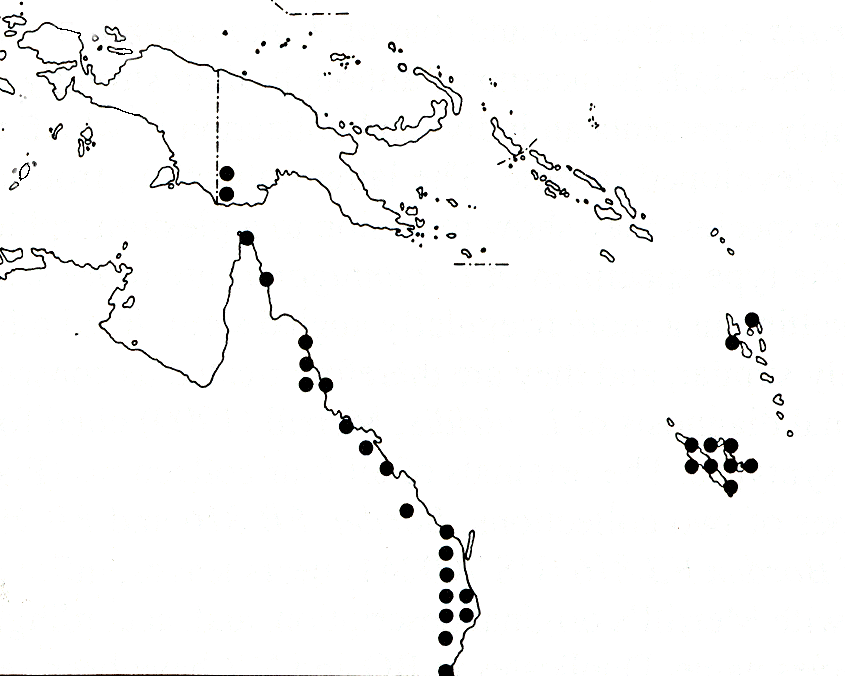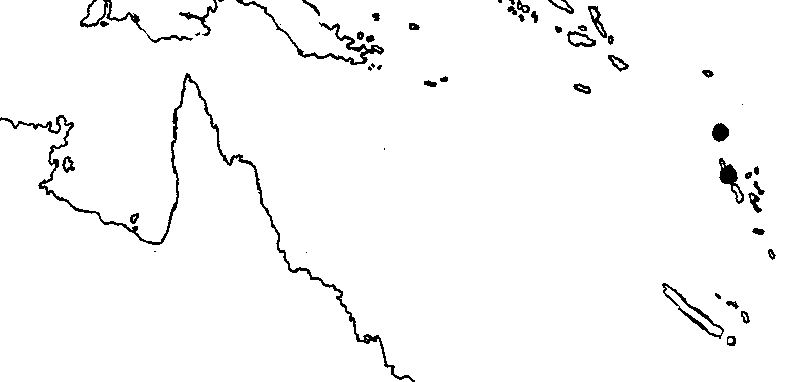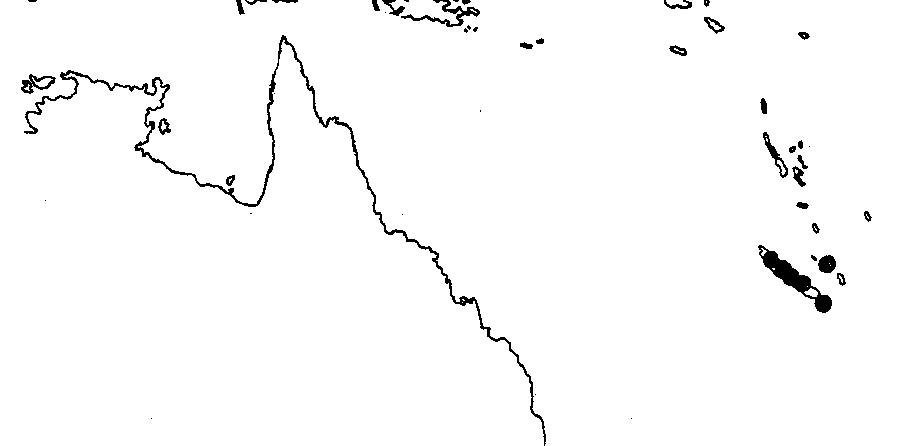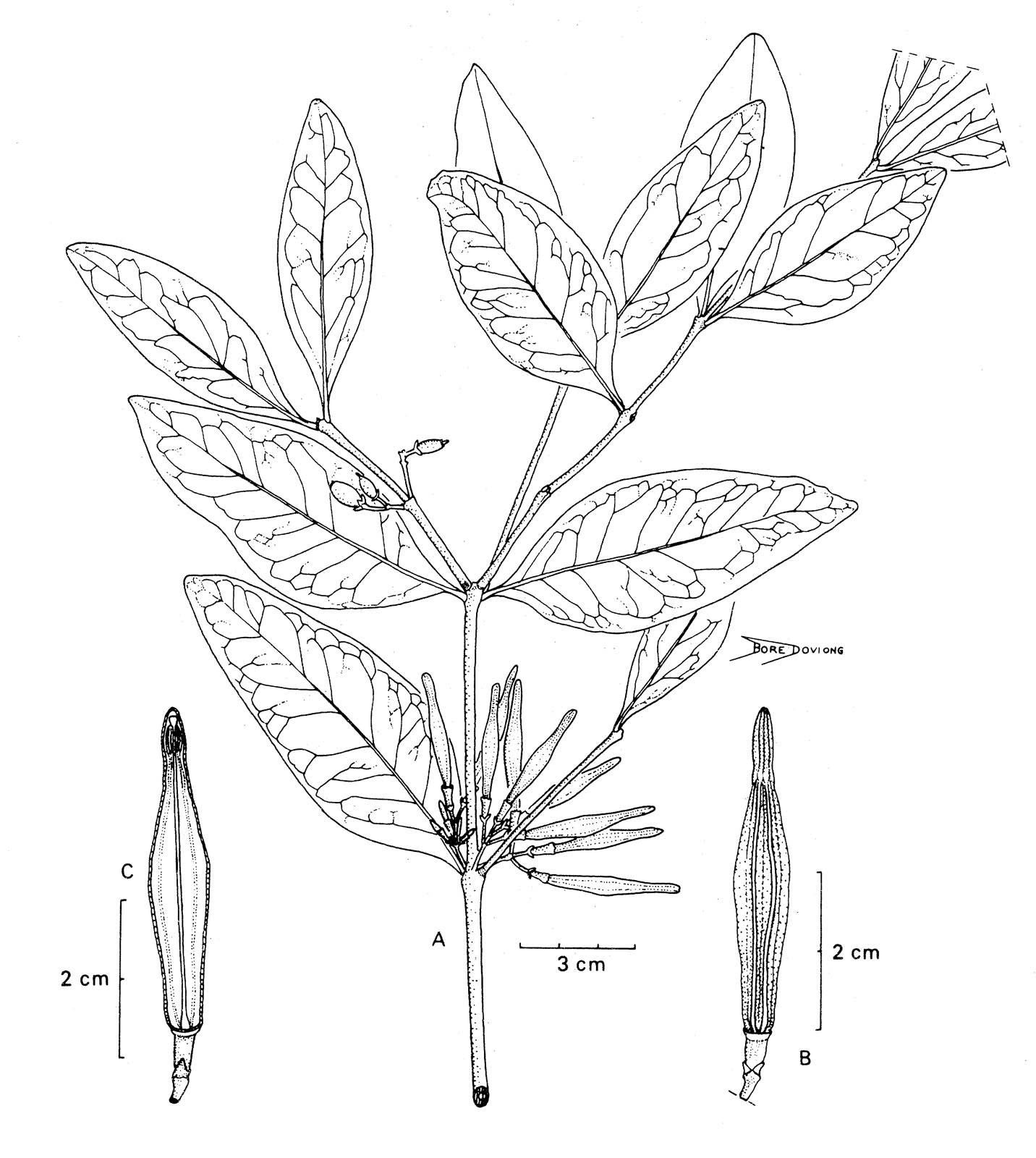
Distribution Map

Description (Barlow 1993)
Amylotheca dictyophleba (F. Mueller) Tieghem
Loranthus dictyophlebus F. Mueller, Rept. Burdekin Exped. (1860) 14. -Amylotheca dictyophleba (p. Mueller) Tieghem, Bull. Soc. Bot. France 41 (1894) 262. - Type: Beckler s.n. (lecto MEL, Barlow 1966; iso NSW), Australia, New South Wales, Hastings R.
Adelia pyramidata Tieghem, Bull. Soc. Bot. France 41 (1894) 436. - Amylotheca pyramidata (fieghem) Danser, Bull. Jard. Bot. Buitenzorg III, 10 (1929) 302. - Type: Pancher 623 (lecto P, Barlow 1974), New Caledonia, Isle of Pines.
Elytranthe banksiana Guillaumin, J. Arnold Arbor. 13 (1932) 88. - Lysiana banksiana (Guillaumin) Danser, Rec. Trav. Bot. N~rl. 31 (1934) 227. -Amylotheca banksiana (Guillaumin) Barlow, Austral. J. Bot. 22 (1974) 546. - Type: Kajewski 453 (holo NY; iso BRI, K, S), New Hebrides, Banks Group, Yanua Lava, 300 m, 10.vii.I928.
For descriptions and extensive further synonymy see Danser, Rec. Trav. Bot. Need. 31 (1934) 227, under Lysiana banksiana; Bull. Jard. Bot. Buitenzorg III, 14 (1936) 81,83, under A. dictyophleba and A. pyramidata; Barlow, Austral. J. Bot. 22 (1974) 546, 547, under A. banksiana, A. dictyophleba and A. pyramidata; Flora of Australia 22 (1984) 73. The species description is amended as follows: Shrub to 2 m in diameter, glabrous. Leaves decussate; lamina lanceolate to elliptic or very broadly ovate, 5-14 cm long, 1.5-12 cm wide, usually shining or rarely dull above, dull below, shortly cuneate to almost truncate at the base to an obscure winged petiole 2-8 mm long, obtuse or rounded or less frequently acute at the apex; venation pennate with reticulate veins usually distinct on both sides. Inflorescences 1-4 in the axils; axis 3-12(-28) mm long, bearing 1-6 decussate, more or less subumbellate pairs of triads or single flowers; triads with the central flowers sessile and lateral flowers pedicellate or sometimes sessile; peduncles of the triads or single flowers 3-7(-10) mm long; pedicels of the lateral flowers of the triads (when present) 2-4 mm long; bracts triangular, acute or obtuse, spreading, 1-1.5 mm long. Ovary narrowly campanulate or cylindrical, 2.5-5 mm long; calyx limb 0.3-0.5(-0.8) mm long. Corolla in the mature bud (28-)35-60 mm long, slightly to strongly inflated at the base, weakly clavate, acute or obtuse or rarely rounded; petals 6, united to about the middle. Anther (3-)5-8 mm long, about equal to the free part of the filament. Style articulate 1-3 mm above the base. Fruit ellipsoid to almost globular, 9-12 mm long.
Amylotheca dictyophleba is recorded from southern New Guinea, eastern Australia, New Caledonia (including Isle of Pines and Loyalty Is), and the New Hebrides (Fig. 9; 200 collections seen), mostly at elevations from sea level to 1000 m but recorded up to 1500 m. The species occurs mostly in primary and secondary rain forest, with very low host specificity, recorded as parasitic on a range of hosts too numerous to itemize here.
The species can be identified by its combination of relatively thin bifacial leaves recurved at the margins and not acuminate at the apex, obscure winged petioles, slender inflorescence parts, and relatively thin corolla mostly 35-60 mm long. The corolla colours are variable, but are commonly red, orange, or yellow, usually paler and commonly yellow or green above, and often becoming darker after anthesis.
Previously (Barlow, 1974) I followed Danser (1936) in accepting A. banksiana, A. dictyophleba, and A. pyramidata as distinct species, although with some reservation. Review of the additional materials available from New Caledonia and New Hebrides shows that these species cannot be maintained as distinct. In vegetative characters they present a relatively homogeneous continuum. The same applies to the floral characters, although there is a tendency for the island populations (New Caledonia and New Hebrides) to have larger flowers than the mainland ones (Australia and New Guinea). Except for the more southerly populations in Australia there is a common tendency for reduction. of inflorescence components, especially of triads to single flowers (Barlow, 1974), and the simple umbels thought to be diagnostic of A. banksiana in the New Hebrides also occur frequently in New Caledonia and northern Australia. For brief notes on the presumed polarity of these inflorescence character states, see under Diagnostic features in the introductory statements.
Amylotheca dictyophleba is apparently a derivative of an intrusive Malesian stock (Barlow, 1990) which became widely established in the Papuasian region, and A. acuminatifolia and A. subumbellata are probably local differentiates from this complex (see notes there). For note on species disjunctions, see under A. duthieana.
Description (Barlow 1974)
Amylotheca dictyophleba (F. Muell.) Tiegh. Bull. Soc. bot. Fr. 41: 262 (1894); Dans. Bull. Jard. bot. Buitenz. 11: 242 (1931); Engl . & Krause, Pfl. Fam.ed. 2 16b: 139 (1935); Barlow, Aust. J. Bot. 14: 439 (1966); Loranthus dictyophlebus F. Muell. Rep. Burdek. Exped. 14 (1860); Aciella dictyophleba (F. Muell.) Tiegh. Bull. Soc. bot. Fr. 42: 87 (1895); Elytranthe dictyophleba (F. Muell.) Engl . Pfl. Fam.Nachtr. 126 (1897). Type-Hastings R., N.S.W., Beckler (MEL, lectotype (Barlow 1966); N5W); Moreton Bay, Queensland, Mueller, 1875 (MEL, syntype); Illawarra, N.S.W., Shepherd (MEL, syntype). For further synonymy see Barlow (1966).
Petiole obscure, winged, 2-8 mm long; lamina lanceolate to elliptical, (6)-8-12 by 2-4-(6) cm, usually shining above, dull below, attenuate to contracted at the base, acute to rounded at the apex; venation distinctly reticulate on both sides. Inflorescences 1-3 in the axils; axis bearing 1-6 decussate, more or less subumbellate pairs of triads or single flowers, 5-12-(28) mm long; peduncles of the triads or single flowers (3)-5-7-(10) mm long; pedicels of the lateral flowers of the triads (when present) 2-4 mm long; bracts single under the flowers or sometimes 2 or 3 where the triads are reduced to single flowers, triangular, acute, 1 mm long. Calyx narrow cylindrical; limb obscure, 03 mm long. Corolla in the mature bud clavate, acute at the apex, (28)-32-38 mm long; petals in the open flower united to about the middle. Anthers 3-4 mm long, slightly longer than the free parts of the filaments. Style articulate 2-3 mm above the base. Fruit globular, 10-12 mm in diam. Chromosome Number.- n = 12 (Barlow 1963).
Occurrence. Eastern New Guinea, recorded from two collections from the Fly R. area (Fig. 3). Also coastal Queensland and New South Wales as far south as the Illawarra District.
Specimens Examined. EASTERN NEW GUINEA:
L. Daviumbu, Middle Fly R., Brass 7587,
Aug. 1936 (L); Weam, Bensbach Subdist., Western Dist., c. 30
m alt., Ridsdale NGF 33540, 31.viii.1967 (LAE).
Distribution Map, Amylotheca banksiana (Guill.) Barlow

Description, Amylotheca banksiana (Guill.) Barlow
Elytranthe banksiana Guill. J. Ar Arb. 13: 88 (1932); Lysiana banksiana (Guill.) Dans. Rec. Tray. bot. Neerl. 31: 233, 227, illus. Fig. 1, a (1934); Bull. Jard. bot. Buitenz. 14: 86 (1936). Type-New Hebrides, Banks Group, Vanua Lava, 300 m alt., Kajewski 453, l0.vii.1928 (NY, holotype; BRI; K; S).
Petiole obscure, up to 08 cm long; lamina oblong to obovate, 5-7-(10) by 8-3-(5) cm, thin, often punctate, gradually attenuate at the base, undulate at the margin and minutely recurved, rounded at the apex; venation obscure except for the midrib prominent on both sides. Inflorescences few in the axils, each consisting of a 2- or 4-flowered apparently simple umbel but actually a subumbellate raceme; peduncle slender, c. 8-10 mm long; pedicels 3-6 mm long; bracts spreading, obtuse, 1 mm long. Calyx cylindrical, 2-3 mm long; limb entire, 0.5-1 mm long. Corolla in the mature bud not or only slightly inflated at the base, thin, 40-50 mm long; petals in the open flower united to about the middle. Anthers c. 6 mm long, about equal to the free parts of the filaments. Style articulate c. 1 . 5 mm above the base, persistent on the fruit. Fruit ellipsoidal, not seen mature. (Fig. 1, d.)
Occurrence. New Hebrides (Fig. 3), 300 to 600 in altitude.
Specimens Examined. NEW HEBRIDES: Navaka R. Valley, Espiritu Santo, c. 600 m alt., Chambers 2682, Aug. 1963 (AD).
Danser (1934, 1936) interpreted the inflorescence of this species as a simple umbel, and consequently placed the species in Lysiana, which is otherwise entirely Australian.
Amylotheca banksiana differs
from the species of Lysiana in the more regular corolla
tube, in the 4-flowered inflorescence, and in the long pyramidal
persistent style base. The inflorescence is most probably an extreme
reduction from the raceme of triads which is the primary inflorescence
type of Amylotheca. Similarly reduced infiorescences are
relatively frequent in A. dictyophleba and A. pyramidata.
Distribution Map of A. pyramidata (Barlow 1974)

Description of A. pyramidata (Barlow 1974)
Amylotheca pyramidata (Tiegh.) Dans. Bull. Jard. bot. Buitenz. 10: 302 (1929);14: 84 (1936); Engl. & Krause, Pfl. Fam.ed. 2 16b: 139 (1935);
Aciella pyramidata Tiegh. Bull. Soc. bot. Fr. 41: 436 (1894); Elytranthepyramidata (Tiegh.) Engl . Pfl. Fam.Nachtr. 126 (1897). Type. Isle of Pines, Pancher 623 (P, lectosyntype); Isle of Pines, Pancher 4586 (= Vieillard 2629) (P, syntype).
Aciella pancheri Tiegh. Bull. Soc. bot. Fr. 41: 437 (1894); Elytranthe pancheri (Tiegh.) Engl . Pfl. Fam. Nachtr. 126 (1897). Type-Isle of Pines, Pancher sn. (P).
Aciella lanceolata Tiegh. Bull. Soc. bot. Fr. 41: 437 (1894); Elytranthe lanceolata (Tiegh.) Engl. Pfl. Fam.Nachtr. 126 (1897); Amylotheca lanceolata (Tiegh.) Dans. Bull. Jard. bot. Buitenz. 10: 301 (1929). Type-New Caledonia, Bay of Tupiti, Deplanche 382 (P, holotype; K; L 9081281058).
Aciella deplanchei Tiegh. Bull. Soc. bot. Fr. 41: 438 (1894); Elytranthe deplanchei (Tiegh.) Engl. Pfl. Fam. Nachtr. 126 (1897). Type-New Caledonia, without exact locality, Deplanche 376 (p).
Aciella lifuensis Tiegh. Bull. Soc. bot. Fr. 41: 438 (1894); Elytranthe lifuensis (Tiegh.) Engl . Pfl. Fam.Nachtr. 126 (1897); Amylotheca lifuensis (Tiegh.) Dans. Bull. Jard. bot. Buitenz. 10: 301 (1929). Type. Loyalty Islands, Island Lifu, Deplanche sn. (P, holotype; K).
Aciella rubra Tiegh. Bull. Soc. bot. Fr. 41: 438 (1894); Elytranthe rubra (Tiegh.) Engl. Pfl. Fam.Nachtr. 126 (1897); Amylotheca rubra (Tiegh.) Dans. Bull. Jard. bot. Buitenz. 10: 302 (1929). Type-New Caledonia, above Ténè near Bourail, 600 m alt., Balansa 1319, 17.iii.1869 (P).
Aciella balansae Tiegh. Bull. Soc. bot. Fr. 41: 439 (1894); Elytranthe balansae (Tiegh.) Engl. Pfl. Fam.Nachtr. 126 (1897); Amylotheca balansae (Tiegh.) Dans. Bull. Jard. bot. Buitenz. 10: 300 (1929). Type-New Caledonia, Mt. Mou, Balansa 2780. Mar. 1870 (P).
Aciella tenuifolia Tiegh. Bull. Soc. bot. Fr. 41: 439 (1894); Elytranthe tenuifolia (Tiegh.) Engl. Pfl. Fam.Nachtr. 126 (1897); Amylotheca tenuifolia (Tiegh.) Dans. Bull. Jard. bot. Buitenz. 10: 302 (1929). Type.-New Caledonia, Mt. Mou, Balansa 2780a, Mar. 1870 (P).
Loranthus oliganthus Schlecht. Bot. Jahrb. 39: 104 (1906); Amyema oligantha (Schlecht.) Dans. Bull. Jard. bot. Buitenz. 10: 297 (1929). Type-New Caledonia, near Outbache, 800 in alt., Schlechter 15513, 20.xii.1902 (a, holotype, not seen, possibly destroyed; P; P; WRSL).
Loranthus francii Schlecht. Bot. Jahrb. 40: Beibl. 92: 23 (1908); Amyema francii (Schlecht.) Dans. Bull. Jard. bot. Buitenz. 10: 295 (1929); Amylotheca francii (Schlecht.) Dans. Bull. Jard. bot. Buitenz. 11: 320 (1931). Type-New Caledonia, Mt. Dzumac, 800 in alt., Franc 58, Apr. 1906 (a, holotype, not seen, possibly destroyed; P; UC 390825; UC 391264).
Loranthus canalensis Moore, J. Linn. Soc. Bot. 45: 391 (1922); Amylotheca danalensis (Moore) Dans. Verh. Akad. Wet. Amst. afd. Natuurk. 29: 36 (1933). Type-New Caledonia, Mt. Canala, 600 m alt., Compton 1110 (BM, not seen).
Loranthus comptonii Moore, J. Linn. Soc. Bot. 45: 391 (1922); Amylotheca comptonii (Moore) Dans. Verb. Akad. Wet. Amst. afd. Natuurk. 29. 36 (1933). Type-New Caledonia, Mt. Mou, Niaouli region, 240 m alt., Compton 600 (BM, not seen).
For further synonymy see Danser, Bull. Jard. bot. Buitenz. 14: 82, 84 (1936).
Petiole, obscure, more or less winged, up to 0.6 cm long; lamina variable, (lanceolate to) elliptical to broadly ovate, widest in or below the middle, 7-14 by (1.8-3-8- (12) cm, dull on both sides or shining above, contracted at the base, usually recurved at the margin, rounded or obtuse at the apex; venation distinctly reticulate on both sides. Inflorescences solitary or few in the axils; axis bearing 1-3 decussate subumbellate pairs of triads or single flowers, 3-1l-(15) mm long; peduncles of the triads or single flowers 3-6 mm long; pedicels of the lateral flowers of the triads (when present) 2-3 mm long; bracts acute, spreading, 1 5 mm long. Calyx campanulate to narrow cylindrical, 3-5 mm long; limb undulate, 05 mm long. Corolla in the mature bud robust, inflated at the base to about twice the width of the calyx, not distinctly clavate, obtuse or rounded at the apex, 45-60 mm long; petals in the open flower united to about the middle. Anthers 6-8 mm long, about equal to the free parts of the filaments. Style articulate c. 1 mm above the base, persistent on the fruit; stigma globose, 3 times as wide as the style. Fruit ellipsoidal.
Occurrence. New Caledonia, Isle of Pines and the Loyalty Islands (Fig. 3), mostly 250 to 800 m altitude.
Representative Specimens. See citations of type specimens above.
Several authors have reported that this plant is able to grow independently in the soil before making haustorial attachments to the aerial parts of the host. For further discussion, see note under Amyema scandens subsp. scandens.
Amylotheca pyramidata is
very similar to A. dictyophleba, differing primarily in
the larger dimensions of the parts and in the inflated corolla
base.
Illustrations

Amylotheca dictyophleba. A - twig with flowers and young fruit. B - flower bud. C - longitudinal section of flower bud. From Barlow (1981).
|
|
|
Amylotheca dictyophleba (as A. banksiana). Inflorescence. From Barlow (1974). |
Photographs

Habit of plant. Queensland, Australia. Photo by Gerhard Glatzel.

Flowers, Queensland, Australia. Photo by Gerhard Glatzel.

Young flowers and fruit. Atherton, Queensland, Australia. Photo by Dan Nickrent
Amylotheca dictyophleba
updated 20 January 2007